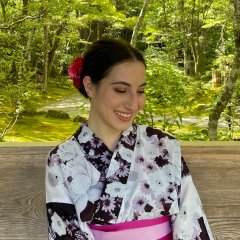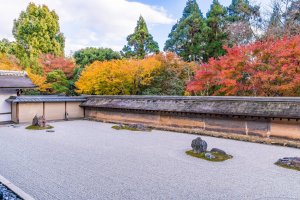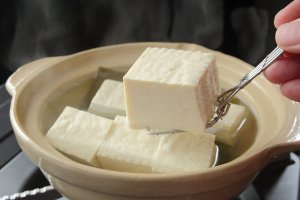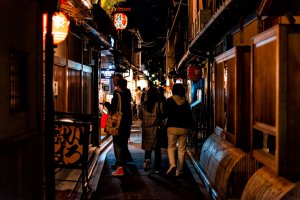Colors connect us all, bringing vibrancy to our lives.
Although colors are inherently visual, we attribute emotions, smells, tastes, and symbolism to them, and it is these senses that guide us through new adventures.
Kyoto Prefecture, renowned for its traditional Japanese culture, is celebrated for its temples, shrines, charming countryside, exquisite food, and more, making it one of Japan’s top destinations. For a unique shift in perspective, let us adventure through Kyoto with colors as our guide. You may find yourself appreciating details and feelings you had not noticed before.
White
While white (shiro) is often related to death and mourning in Japan, it is also a symbol of purity. White absorbs light and is a reflection of all colors, presenting as a bright, yet simple shade. Refresh your senses with this brilliant hue.
Nijo Castle

Nijo Castle (or Nijo-jo), built in 1603, was the Kyoto residence of Tokugawa Ieyasu, the first Shogun of the Edo Period. The castle’s gardens, intricate gates, grand palaces, tea houses, moats, and more make it a rainbow of colors in itself. However, perched atop the outer stone walls and across the moat stand the imposing east gate, southwest watchtower, and southeast watchtower, all of which shine white. These famous landmarks sport dark curved roofs that accentuate the plain facades. White accents are also interspersed throughout the castle’s design and shine even more brightly than their golden counterparts.
- 541 Nijojocho, Nakagyo Ward, Kyoto, 604-8301
- 8:45 - 16:00 (Open Now)
- ¥620
Ryoanji

For an introspective and zen experience, visit Ryoanji Temple, which is home to Japan’s best-known rock garden. Ryoanji was converted into a temple in 1450 and belongs to the Myoshinji school of the Rinzai sect of Zen Buddhism. The meticulous display of raked white pebbles is interspersed with 15 large-to-medium sized stones. The larger rocks are strategically placed so you can only observe 14 rocks at one time, no matter your positioning. Although the meaning of the garden is unclear, the pure landscape of carefully arranged stones facilitates peace and self-reflection.
- 13 Ryoanji-Goryo-no-Sita-cho, Ukyo-ku, Kyoto City
- 8:30 - 16:30 (Open Now)
Yudofu

Yudofu is a Kyoto food specialty and, in its simplest form, is made by simmering tofu in water flavored with dried kelp. The freshly made silken tofu is often paired with scallions, grated daikon radish, and dipping sauces, such as soy or ponzu sauce. The tofu’s soft texture is compared to that of custard, and its warmth creates a cozy dining experience. Visit one of Kyoto’s many yudofu restaurants and embrace the simplicity of the meal.
Geisha and Maiko
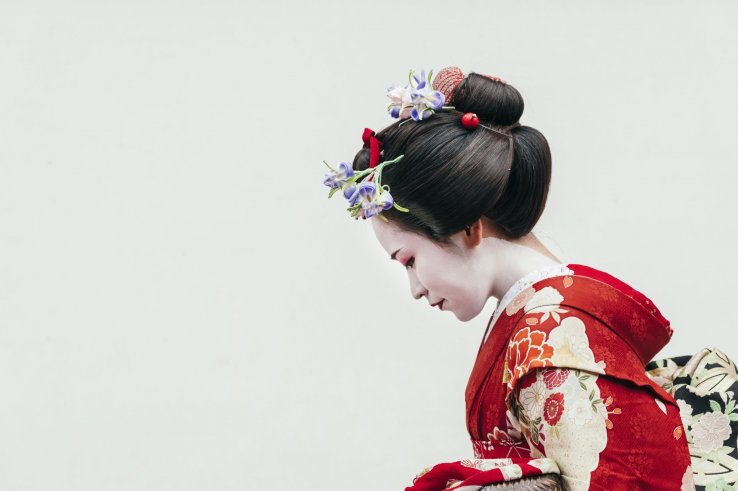
Geisha, also called geiko, and maiko (geisha in training) are women entertainers who are highly skilled in traditional Japanese hospitality. These young women are known for their white face makeup, red lips, beautiful kimono, and intricately styled hair. As Kyoto is the heart of Japan’s geisha society, it is a popular spot for visitors to dine with, watch, dress up, or simply glimpse these elusive entertainers. The women’s white-painted faces are recognizable internationally and are a symbol of elegance.
Black
In Japan, black (kuro) traditionally means death, destruction, mourning, power, and evil. By definition, black is the absence of light and, thus, has a mysterious quality to it, which can be attributed to its likeness to the night. Kyoto’s nightlife offers a unique juxtaposition of traditional ambiences and modern, high-energy vibes.
Pontocho

Immerse yourself in the alluring qualities of night by taking a stroll down Kyoto’s famous alley, Pontocho. This narrow street, paved with stones and lined with dining establishments, features traditional wooden architecture set aglow by soft lantern light. Restaurants on the eastern side of the alleyway sit along the Kamo River. As most establishments open around 5 pm, the street truly comes to life at night. Pontocho offers a range of restaurants, bars, and shops with varying price points. However, the street is most well known for its highly exclusive tea houses and is a common place to spot geisha making their way to appointments.
Kurama Fire Festival

Kurama, a rural mountain town north of Kyoto City, is home to a unique festival and powerful display of fire. Every year, the townspeople reenact the 940 relocation of Yuki-jinja Shrine from Kyoto to Kurama in which locals lit fires to help guide the deities to their new location. Once the sun sets on October 22nd, children, teenagers, and men parade through the village in traditional clothing carrying torches and later, mikoshi (portable shrines). Some of the larger torches can weigh up to 80 kilograms! The contrast of the flames against the black night along with the contagious energy of festival goers creates an awe-inspiring experience.

Kurama Fire Festival 2026
The Kurama Five Festival is one of the most spectacular events in Kyoto and takes place every year on the evening of October 22nd...
Kyoto’s Nightlife

After your fill of traditional fun, have a drink and party the night away at Kyoto’s bars, night clubs, and live music spots. These establishments range from cozy bar environments with live music to heart-pounding night club scenes. Do not forget karaoke either! With darkness as a cover, let go of your inhibitions and create a night you will not (or maybe will) forget.
Red
Red (aka) is a frequently used and powerful color in Japan. The fiery color is associated with energy, heat, power, love, and passion, and is commonly used in temples as it is said to protect people from evil. Kyoto’s brilliant red temples and shrines are some of its greatest wonders and, with the changing seasons, Kyoto offers phenomenal spots to view the autumn leaves.
Fushimi Inari Shrine

Journey through a vermilion tunnel of more than 10,000 tightly packed torii gates up a forested mountainside. These iconic gates, called Senbon Torii, are the most popular sight at Kyoto’s Fushimi Inari Shrine. The ancient shrine has roots in the eighth century and is dedicated to Inari, the Shinto god of good harvest and business. The main shrine grounds are located at the base of Mount Inari and feature gorgeous shrine structures and fox (kitsune) statues.
Senbon Torii begins at the back of the shrine. The entire hike to and from the summit takes about two to three hours. Alternatively, many individuals choose to hike halfway up the mountain to a lookout point that has a restaurant, souvenir shop, and exceptional views of Kyoto.
- 68 Fukakusa Yabunouchicho, Fushimi Ward, Kyoto
- Open 24 hours (Open Now)
Byodoin Temple

Byodoin is a Pure Land Buddhist temple founded in the early 11th century and built to mirror the Pure Land, a place of unimaginable beauty. The Phoenix Hall, or Amida-do, is the temple’s most remarkable buildings thanks to its bright red facade, contrasting white detailing, slanted roofs, and waterside positioning. This historic hall is one of the few remaining structures from the Heian Period and is located on a small island in the temple’s central pond. The hall’s symmetrical composition gives it the appearance of a phoenix in flight and, on still days, you can witness this enchanting sight reflected in the pond’s water.
Kiyomizudera

It is no secret that Japan’s temples and shrines exemplify the color red. However, this bright color is also celebrated during autumn in Kyoto. Kiyomizudera, one of Japan’s top temples, is a famous spot to observe the seasonal shift. The eighth-century temple is located on Otowa Hill and features a wooden stage that extends out from the main hall. From this vantage point, you are treated to a remarkable panorama of red maple trees. Once the sun sets, the temple illuminates the leaves in a fiery display of color. Aside from the brilliant foliage, you can also admire the temple’s three-storied vermillion pagoda and bell tower.
- 1-294 Shimizu, Higashiyama-ku, Kyoto, Kyoto Prefecture
- 6:00 - 18:00 (Open Now)
- ¥200 - ¥400
Blue
Water often evokes a sense of peace. A riverside walk or the rythmic sound of a waterfall eases the mind. Being an island, Japan is well connected to its surrounding waters. Therefore, blue (ao) is traditionally symbolic of water and represents purity, cleanliness, calmness, and stability.
Amanohashidate

Amanohashidate, which roughly translates to “bridge to heaven,” is a narrow strip of land that extends across Miyazu Bay in northern Kyoto. This sandy pathway, lined on both sides by vivid blue water and populated by nearly 8,000 pine trees, is regarded as one of Japan’s three most scenic views. Walk or bike along the three-kilometer sandbar, through its famous pine trees, or relax on its white-sand beaches. For a truly mesmerizing aerial view, visit the hills on either side of the bay. Amanohashidate View Land is an especially popular observation spot on the southern side of the sandbar. From this elevated position, the composition of white beaches, dense pine trees, and blue waters creates a scene that rightly earns the name, bridge to heaven.
Kamo River

Kamo River (Kamogawa), which weaves through Kyoto City, offers a perfect natural retreat that evolves from dawn to dusk. During the early morning, the river is a popular place for locals to walk, jog, and cycle. As morning gives way to afternoon, the river’s grassy areas become populated by picnickers and city folk looking for a place to relax. Finally, when the sun sets, the area transforms into a mystical one as the dark currents reflect the amber glow of the surrounding buildings. During the summer, many eateries, especially in the previously-mentioned Pontocho area, open dining platforms along the water.
Gold
Gold (kin) is a distinguished color that represents wealth and is frequently used to decorate religious artifacts, shrines, and temples to emphasize their importance. The relative rareness of this color in everyday life makes it an especially special treat to observe.
Kinkakuji

Kinkakuji Temple, located in northern Kyoto, is one of Japan’s most popular destinations, and for good reason. The Zen temple’s two top floors are entirely covered in gold leaf, and the temple itself is situated atop a large pond surrounded by lush nature. The golden building is otherworldly during all seasons, whether it be against pure snow or autumn foliage. Although you cannot enter the golden pavilion, the majestic view from the waterside is reason enough to visit.
- 1 Kinkakujicho, Kita Ward, Kyoto, Kyoto Prefecture
- 9:00 - 17:00 (Open Now)
- ¥400
Nishi Honganji Temple

Nishi Honganji is a temple complex located in central Kyoto and one of the head temples of the Jodo Shinshu sects of Buddhism, the most mainstream form of Buddhism in Japan. The temple's design features black exteriors decorated with intricate gold, blue, green, and red detailing. The Bell Tower and Karamon Gate both exemplify this style with their ornate facades, while the Goeido and Amidado, which are both worship halls, continue the design inside with their gold-embellished altars. The temple is also home to an over 400-year-old ginkgo tree, which, from mid to late November, turns a vibrant shade of yellow, matching the temple’s golden embellishments.
- Hanayacho-sagaru, Horikawa-dori, Shimogyo-ku, Kyoto, 600-8501
- 5:30 - 17:00 (Open Now)
Green
Green (midori) is the color of nature and symbolizes fertility, growth, youth, energy, and vitality. Nature is an integral part of Japanese culture and preserved in the country’s pristine parks and gardens. With the hecticness of modern life, nature offers an escape to revitalize the body, mind, and soul.
Arashiyama Bamboo Forest

Arashiyama Bamboo Forest, located in the nature-filled district of Arashiyama on the western outskirts of Kyoto, is a one-of-a-kind nature excursion. Walk among a sea of green on an earthen path to the whispering of swaying bamboo trees. The tranquil sound is so enchanting, that Japan’s Ministry of the Environment designated it as one of the “100 Soundscapes of Japan.” The slender, yet tall plants reach to the sky, providing a soft canopy that filters the sun’s rays in an ethereal display. Take a moment to close your eyes and become one with the trees.
- Sagatenryuji Tateishicho, Ukyo Ward, Kyoto, 616-8375
- Open 24 hours (Open Now)
Matcha in Uji

With your hands around a warm cup of matcha tea, inhale the earthy aroma and take a sip. The composition of grassy, slightly sweet, and balanced bitter notes both energizes and relaxes the body. Uji, a short train ride south of Kyoto City, is famous for its refined green tea and matcha production. Immerse yourself in the city’s tea culture by sampling and learning about the cultivation process at a tea house or by enjoying one of the many green tea-themed delicacies, such as green tea soba noodles, green tea ice cream, green tea shaved ice, and more! For a traditional experience take part in a tea ceremony at one of the local tea houses, where you can learn about proper tea preparation and drink etiquette.

